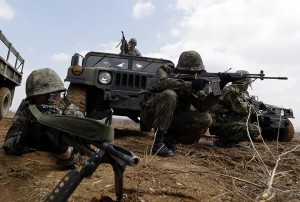

Associated Press
JOINT BASE PEARL HARBOR-HICKAM, Hawaii — The United States sent its most powerful airplanes to the Korean peninsula in recent weeks in part because it wants North Korea to know what the American military is capable of doing, the top U.S. Air Force commander in the Pacific said.
B-2 stealth bombers, F-22 stealth fighters and B-52 bombers have recently all flown to South Korea for exercises or short deployments in what amounted to a dramatic display of U.S. air power. The stealth planes are capable of sneaking past radar undetected. B-2 and B-52 bombers are capable of delivering nuclear weapons.
“Every morning that a potential adversary gets up and goes, ‘You know what, I’m not going to mess with America today’ — that’s a good morning,” Gen. Herbert Carlisle said Tuesday in an interview at his headquarters in Hawaii. “We need all those mornings to keep coming.”
The U.S. is hoping a missile defense system it’s sending to Guam, a U.S. territory and strategically important military outpost 1,500 miles south of Tokyo, will have the same deterrent effect, he said.
If “they know we got something that can knock down their missiles — it may stop them from shooting them,” Carlisle said.
The U.S. has also explained it’s reassuring its allies by showing it’s prepared to defend them.
The missile defense system — called Terminal High Altitude Area Defense — is designed to intercept missiles during their final stage of flight. It joins other technology the military has to intercept missiles during their initial and midflight phases.
Carlisle said the U.S. also is considering sending high-altitude surveillance planes from Guam to Japan during the tropical island’s summer storm season. Often, typhoons and thunderstorms around Guam ground the Global Hawk drones from April through November. The planes would be less likely to face weather problems if they were flying out of a place like Misawa Air Base in northern Japan, Carlisle said.
The U.S. uses the drones to monitor North Korea and could do so from Japan as well, Carlisle said.
“They could do all the missions that they do now if they were flying out of Japanese bases,” he said.
Tokyo is also considering buying some of the drones for its own use, Carlisle said.
“We’re still working it with the Japanese government. I don’t know whether we’ll do it this year or not. It does cost money to do that, again that’s another factor. We’re still examining it and looking at how to make it happen. When we do it is another question,” he said.
Cost is an issue as the Air Force copes with automatic federal budget cuts imposed when Congress failed to reach a deal to avert them.
The Pacific is least affected among other parts of the Air Force because of the Obama administration’s emphasis on Asia and the Pacific and because of current tensions on the Korean peninsula. Even so, an F-16 squadron in Alaska — 18th Aggressor Squadron at Eielson Air Force Base— is being grounded along with others elsewhere in the country.
Carlisle said the Air Force’s core activities — maintenance and operations — are disproportionately affected because the military lacks the flexibility to cut other spending.
Congress didn’t allow the branch, for example, to cancel acquisitions programs even when they’re behind schedule or not meeting requirements, he said. It also can’t cut airmen salaries or health care coverage.
On top of this, the Air Force is implementing a year’s worth of budget cuts in six months. That’s because the services were told Congress would come to an agreement to avoid the budget cuts and so the Air Force didn’t plan for them when the current fiscal year started in October.





